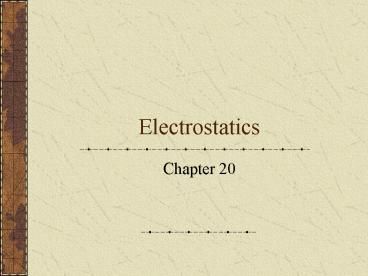Electrostatics - PowerPoint PPT Presentation
1 / 12
Title:
Electrostatics
Description:
Electrostatics. Chapter 20. Electrostatics. The study of electrical charges, how ... 1. What is an electron and what is its charge? 2. What is a proton and what ... – PowerPoint PPT presentation
Number of Views:72
Avg rating:3.0/5.0
Title: Electrostatics
1
Electrostatics
- Chapter 20
2
Electrostatics
- The study of electrical charges, how they can be
collected and held in one place.
3
Chemistry Review
- 1. What is an electron and what is its charge?
- 2. What is a proton and what is its charge?
- 3. What is a neutron and what is its charge?
- 4. What is an atom and what is its charge?
- 5. What is an ion and what is its charge?
- 6. What determines the properties of an atom?
- 7. What can you remove from an atom in this
class....proton neutron or electron?
4
Chemistry Review
- What is an electron and what is its charge? (-)
- What is a proton and what is its charge? ()
- What is a neutron and what is its charge? (no
charge) - What is an atom and what is its charge? (no
charge) - What is an ion and what is its charge? ( or -)
- What determines the properties of an atom?
- (Atomic Number/Number of protons)
- What can you remove from an atom in this
class....proton neutron or electron? - (electron)
5
PROTONS AND NEUTRONS CANNOT BE REMOVED WITHOUT A
NUCLEAR REACTOR
- We are not building one in class. Sorry.
- -The Management
6
Basic Definitions
- Conductors allow electrons to flow freely.
- Insulators dont allow electrons to flow.
- Semiconductors kind of allow electrons to flow.
- Superconductors allow electrons to flow without
resistance.
7
Forces between Charged Particles
- Coulombs Law F k q1q2 / d2
- Textbook version F kqq/d2
- k 9x109 Nm2/C2
- q charge in coulombs (C)
- d distance (m)
- The Coulomb is the SI unit of charge.
- 1C charge of 6.25x1018 electrons
8
Coulomb vs Newton
- Although they look almost identical, they are in
fact, two different forces of very different
size. - Coulombs Law F k q1q2 / d2
- Newtons Law F G m1m2 / d2
- Using the values from 1 atom of Hydrogen, solve
for each force - qe -1.6 x 10-19 C qp 1.6 x 10-19 C
- me 9.1 x 10-31 kg mp 1.7 x 10-27 kg
- d 5.3 x 10-11 m
9
Coulomb vs Newton
- Fg G mpme / d2 3.7 x 10-47 N
- Fe k qeqp / d2 8.2 x 10-8 N
- That means that the Electrical force between one
proton and one electron is 1039 or
1,000,000,000,000,000,000,000,000,000,000,000,000,
000 times greater than the Gravitational force
between them!
10
Electrical vs Gravitational Forces
- And since the electrical force is the major force
holding atoms together, this is why you dont
fall through the floor. The force of gravity
pulling you down is no where near as great as the
electrical force holding the linoleum tile
molecules together!
11
Charge Polarization
- The temporary separation of charge.
12
Charging Objects
- Charging by Conduction direct contact.
- Charging by Induction no direct contact.
- Charging by Friction by rubbing together.
- Electroscope device used to detect charges.































